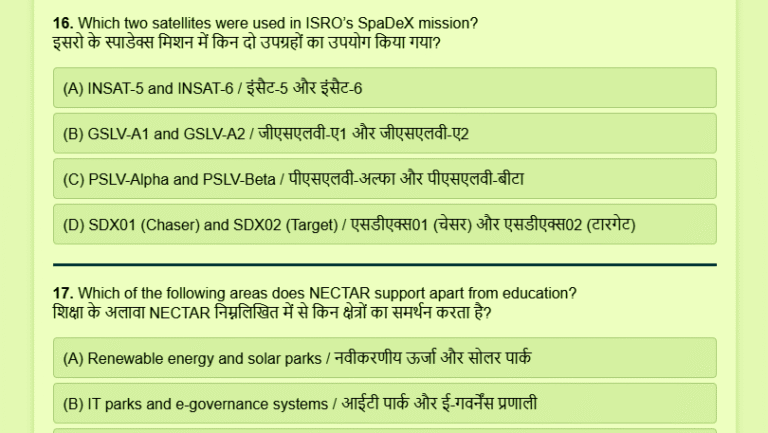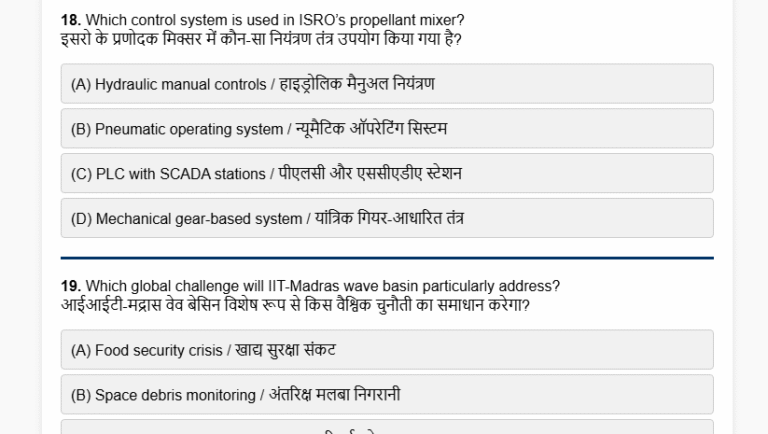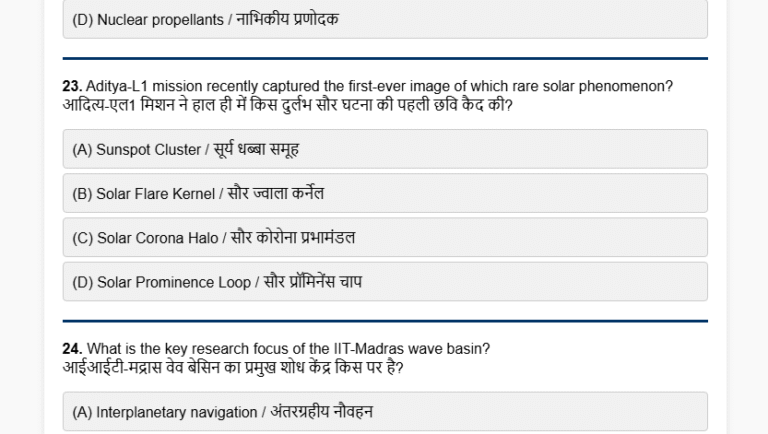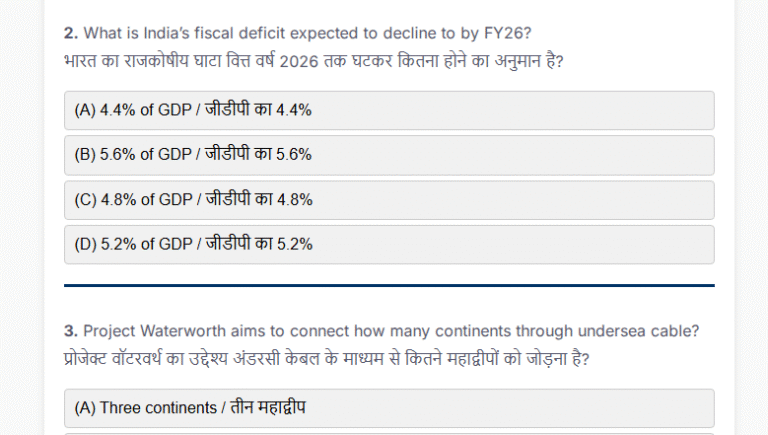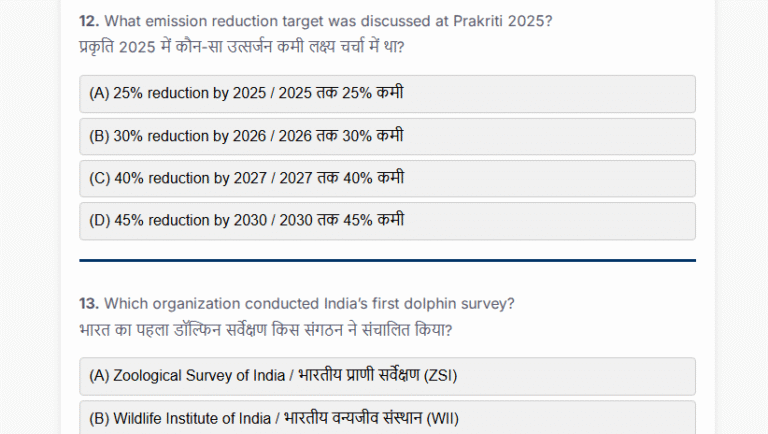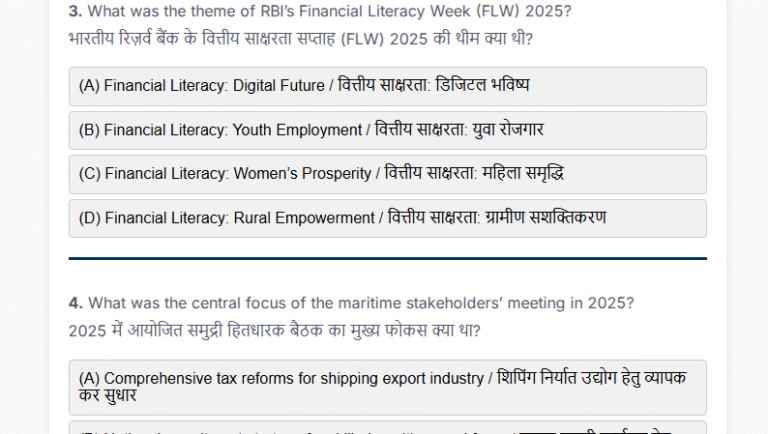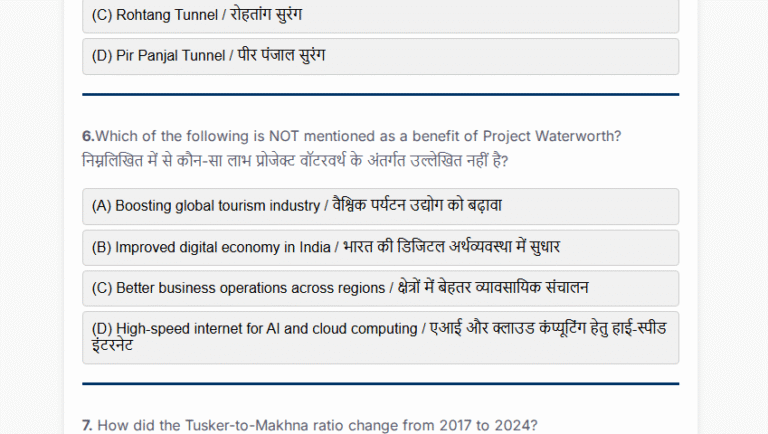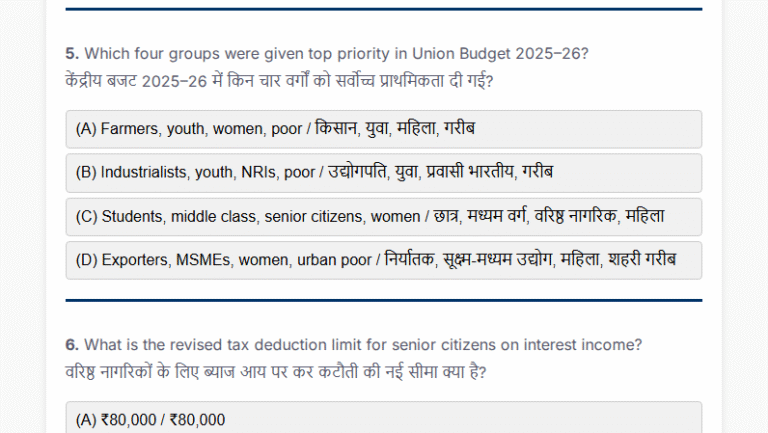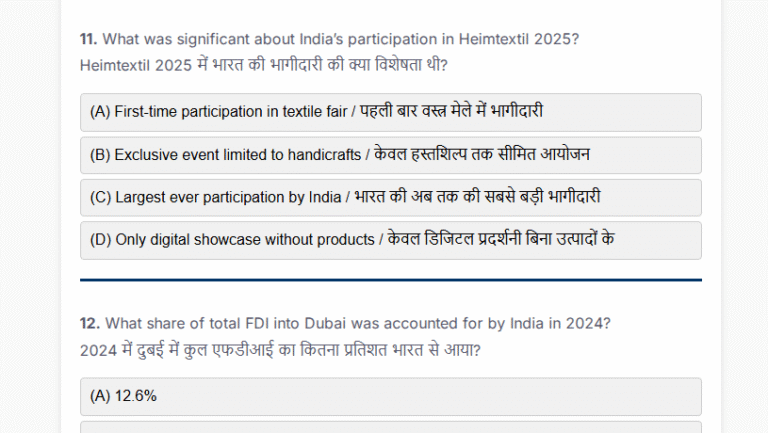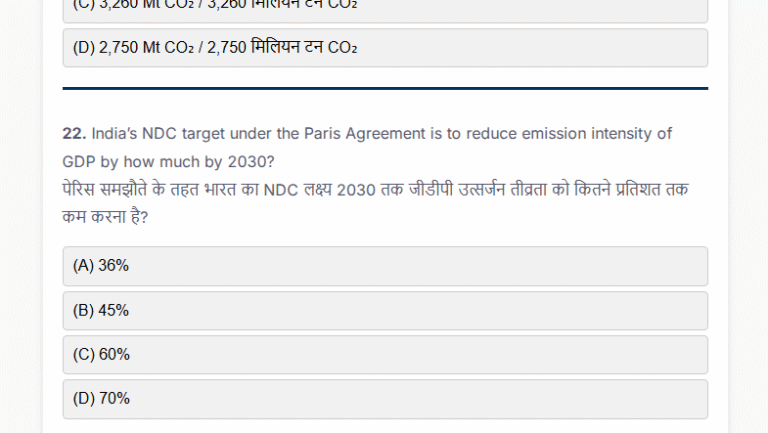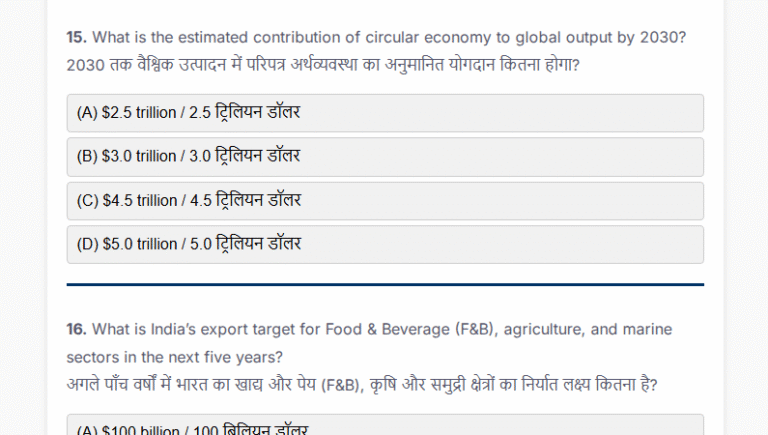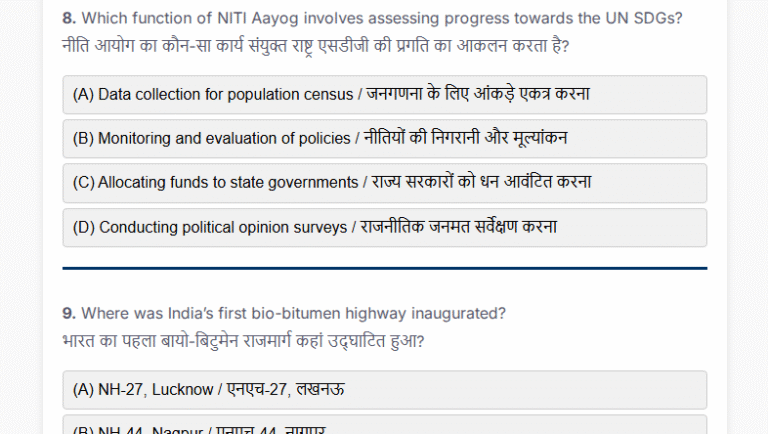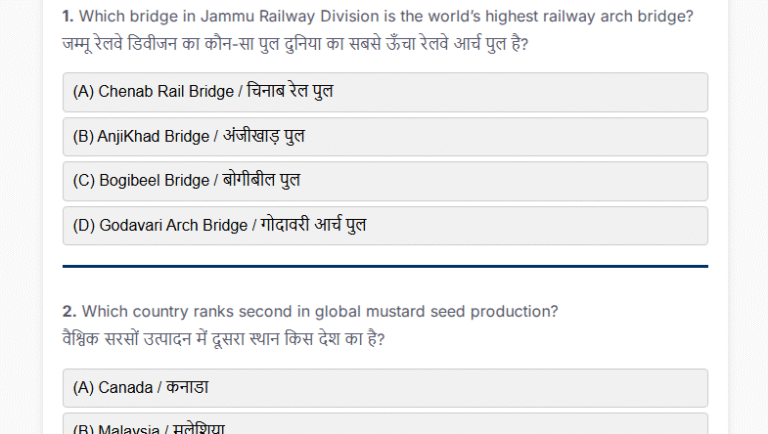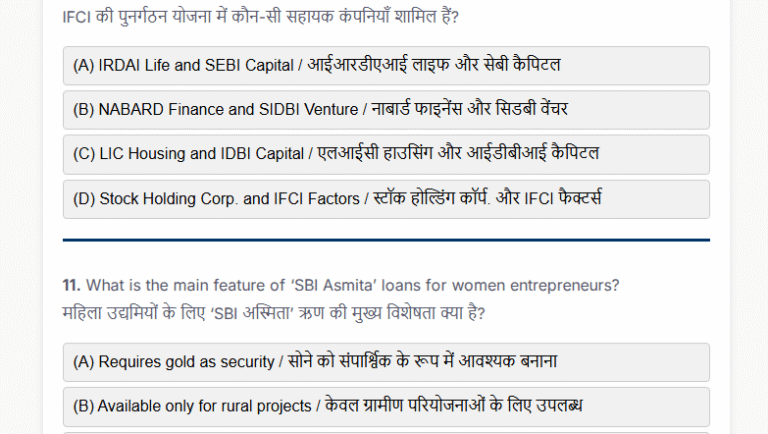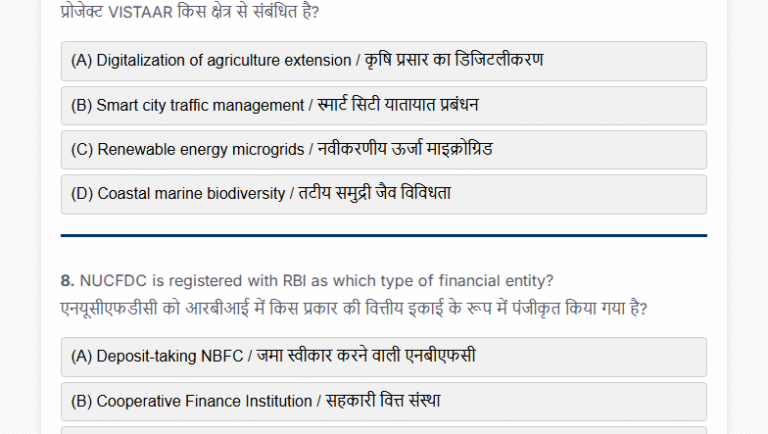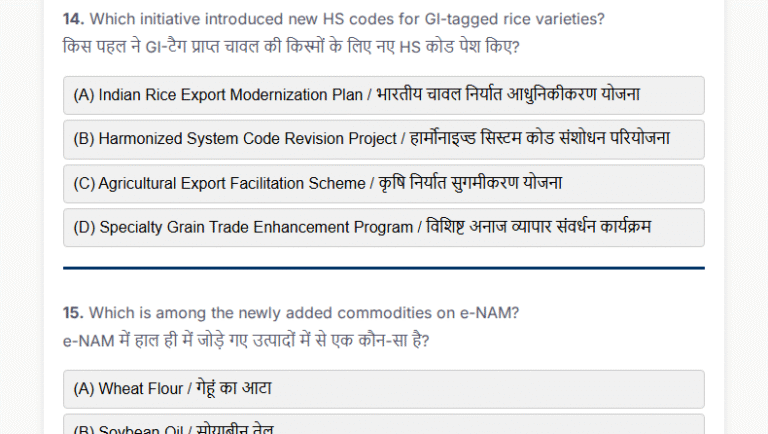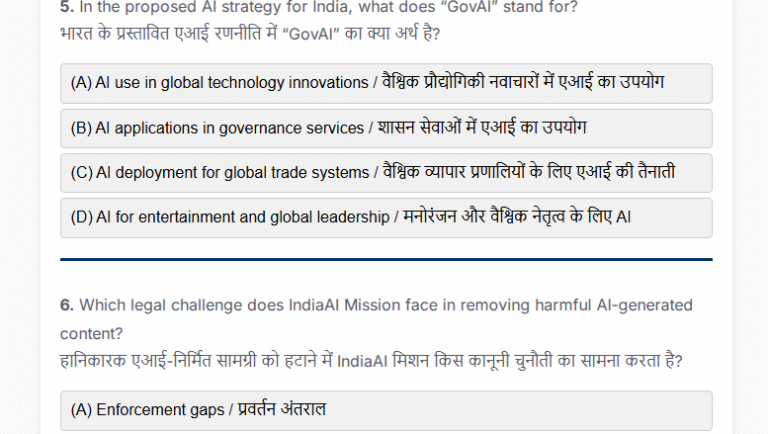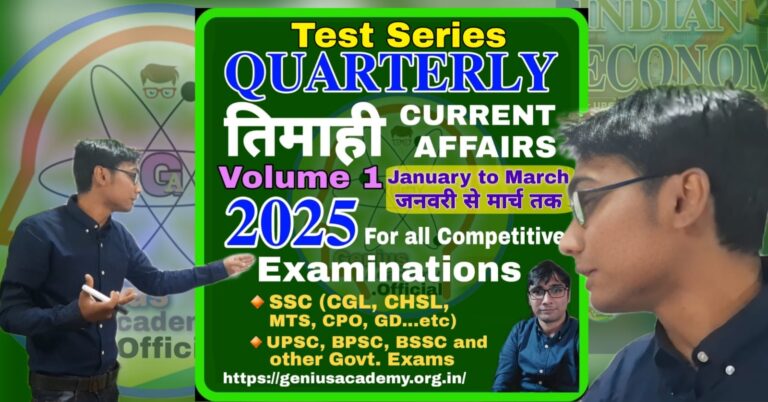Current Affairs Today MCQs (25 Nov 2024)
1. What feature distinguishes African penguins from other penguin species?
(A) They have wings instead of flippers
(B) They exhibit pink skin patches above their eyes
(C) They can fly short distances
(D) They are found in the Northern Hemisphere
The correct answer is (B) They exhibit pink skin patches above their eyes
African penguins have unique pink patches above their eyes, which help regulate body temperature. Found only in Namibia and South Africa, they are monogamous and face threats from predators, climate change, and food scarcity.
2. Who were the recipients of the Indira Gandhi Peace Prize 2023?
(A) Malala Yousafzai and Kailash Satyarthi
(B) Indian Medical Association and Trained Nurses Association of India
(C) Greta Thunberg and Leonardo DiCaprio
(D) Daniel Barenboim and Ali Abu Awwad
The correct answer is (D) Daniel Barenboim and Ali Abu Awwad
Daniel Barenboim, an Argentine-born pianist, and Ali Abu Awwad, a Palestinian peace activist, were awarded the Indira Gandhi Peace Prize 2023 for their contributions to peacebuilding and harmony in the Middle East.
3. What is the maximum range of the Army Tactical Missile System (ATACMS)
(A) 150 km
(B) 200 km
(C) 300 km
(D) 500 km
The correct answer is (C) 300 km
The ATACMS, a short-range ballistic missile, is capable of striking targets up to 300 km away. Developed in the 1980s, it was initially designed to counter Soviet military assets and remains a key tool for precision strikes in modern warfare.
4. Which South African law protects African penguins?
(A) Sea Birds and Seals Protection Act (1973)
(B) Marine Species Preservation Act (1990)
(C) Antarctic Wildlife Act (1985)
(D) Coastal Biodiversity Conservation Act (2001)
The correct answer is (A) Sea Birds and Seals Protection Act (1973)
The Sea Birds and Seals Protection Act of 1973 and subsequent regulations, like the Marine Threatened or Protected Species Regulations (2017), protect African penguins by banning their capture and preventing harm to them or their eggs.
5. Which of the following states does the Teesta River flow through before joining the Brahmaputra?
(A) Assam and West Bengal
(B) Sikkim and Assam
(C) Sikkim and West Bengal
(D) Arunachal Pradesh and Assam
The correct answer is (C) Sikkim and West Bengal
The Teesta River originates in the Tibetan Plateau and flows through the Indian states of Sikkim and West Bengal before entering Bangladesh, where it merges with the Brahmaputra River. This geographical trajectory makes it a critical water source for these regions, influencing both ecology and livelihoods.
6. Why has the Teesta River been identified as a threat to Sikkim and West Bengal?
(A) Increasing sedimentation
(B) Monsoon-related flooding
(C) Poor biodiversity conservation
(D) Declining pilgrimage activities
The correct answer is (B) Monsoon-related flooding
The Teesta River poses a significant threat during the monsoon season due to its potential for causing severe floods. Community-based organisations have raised concerns over inadequate mitigation measures, emphasizing the urgency of addressing this issue before the 2025 monsoon.
7. What is Khecheopalri Lake, and where is it located?
(A) A crater lake in Arunachal Pradesh
(B) A saltwater lake in West Bengal
(C) A man-made reservoir in Assam
(D) A sacred lake in Sikkim
The correct answer is (D) A sacred lake in Sikkim
Khecheopalri Lake is a sacred lake located near the Teesta Valley in Sikkim. It holds religious significance and attracts both pilgrims and trekkers. Its proximity to the biologically rich Teesta Valley makes it an integral part of the region’s cultural and ecological landscape.
8. According to Article 82 of the Indian Constitution, who is authorized to enact a Delimitation Act after every Census?
(A) The State Governments
(B) The Supreme Court
(C) The Parliament
(D) The Election Commission
The correct answer is (C) The Parliament
Article 82 empowers the Parliament to enact a Delimitation Act after every Census. This law provides the framework for redefining constituencies to ensure fair representation based on population changes, thus maintaining electoral equity.
9. Which of the following members is not part of the Delimitation Commission?
(A) Chief Election Commissioner
(B) Retired Supreme Court judge
(C) Respective State Election Commissioners
(D) Lok Sabha Speaker
The correct answer is (D) Lok Sabha Speaker
The Delimitation Commission is composed of a retired Supreme Court judge, the Chief Election Commissioner, and respective State Election Commissioners. The Lok Sabha Speaker is not a member of this commission. This composition ensures impartiality and adherence to constitutional principles during the delimitation process.
10. What is the primary source of the Teesta River?
(A) Himalayan glaciers in Arunachal Pradesh
(B) Tibetan Plateau
(C) Gangotri Glacier
(D) Meghalaya Hills
The correct answer is (B) Tibetan Plateau
The Teesta River originates in the Tibetan Plateau and flows southward through the Indian states of Sikkim and West Bengal before joining the Brahmaputra River in Bangladesh. This makes it a transboundary river of ecological and political significance.
11. What is the primary purpose of the Delimitation Commission in India?
(A) To draw boundaries between state
(B) To resolve interstate disputes
(C) To monitor election campaigns
(D) To fix limits of territorial constituencies for elections
The correct answer is (D) To fix limits of territorial constituencies for elections
The Delimitation Commission is tasked with determining the number and boundaries of constituencies to ensure equitable population representation. It also identifies seats reserved for Scheduled Castes and Scheduled Tribes based on population data.
12. Under which article of the Constitution does the Delimitation Act provide for the division of states into territorial constituencies?
(A) Article 324
(B) Article 356
(C) Article 82
(D) Article 170
The correct answer is (D) Article 170
Article 170 of the Indian Constitution provides for the division of states into territorial constituencies as per the Delimitation Act. This is aimed at ensuring proportional representation in state legislative assemblies.
13.Which of the following years did not witness the formation of a Delimitation Commission in India?
(A) 1952
(B) 1973
(C) 1985
(D) 2002
The correct answer is (C) 1985
Delimitation Commissions in India were constituted in 1952, 1963, 1973, and 2002 under respective Delimitation Acts. No such commission was formed in 1985, making it an incorrect option.
14. What makes the Teesta Valley a biologically rich area?
(A) High agricultural output
(B) Presence of diverse flora and fauna
(C) Large-scale industrialization
(D) Rich mineral deposits
The correct answer is (B) Presence of diverse flora and fauna
The Teesta Valley in Sikkim is renowned for its biodiversity, hosting a variety of flora and fauna. Its unique ecology supports numerous species, making it a critical zone for conservation and sustainable development efforts.
15. Which feature of Khecheopalri Lake contributes to its status as a sacred site?
(A) Its proximity to the Teesta River
(B) Its geological formation
(C) High tourist footfall
(D) Local legends and religious significance
The correct answer is (D) Local legends and religious significance
Khecheopalri Lake is revered by local communities and pilgrims due to its religious and spiritual importance. It is believed to fulfill wishes, and its pristine environment attracts trekkers and nature enthusiasts alike.
16. What is the primary purpose of cloud seeding?
(A) To reduce global warming
(B) To combat air pollution
(C) To induce artificial rainfall
(D) To prevent hurricanes
The correct answer is (C) To induce artificial rainfall
Cloud seeding is a weather modification technique designed to induce artificial rainfall by introducing chemicals like silver iodide or potassium iodide into existing clouds. These chemicals act as nuclei for moisture in the air to condense, which accelerates rainfall, making it useful for drought relief and other applications.
17. Which of the following chemicals is commonly used in the glaciogenic method of cloud seeding?
(A) Potassium iodide
(B) Silver iodide
(C) Salt particles
(D) Liquid propane
The correct answer is (B) Silver iodide
The glaciogenic method of cloud seeding involves using silver iodide or dry ice to induce ice crystal formation in supercooled clouds. This process helps trigger precipitation. However, concerns about the environmental impact of silver iodide persist.
18. Which Indian states have implemented cloud seeding techniques for drought relief?
(A) Karnataka, Andhra Pradesh, and Maharashtra
(B) Rajasthan, Gujarat, and Punjab
(C) Uttar Pradesh, Bihar, and Jharkhand
(D) Kerala, Tamil Nadu, and Goa
The correct answer is (A) Karnataka, Andhra Pradesh, and Maharashtra
India has attempted cloud seeding in states like Karnataka, Andhra Pradesh, and Maharashtra to address water scarcity and drought conditions. The technique has shown varying degrees of success depending on atmospheric conditions.
19. What makes Nafithromycin a significant development in India’s healthcare sector?
(A) It is India’s first antiviral drug
(B) It is a cure for tuberculosis
(C) It targets antimicrobial resistance (AMR)
(D) It eradicates bacterial infections entirely
The correct answer is (C) It targets antimicrobial resistance (AMR)
Nafithromycin, developed indigenously with support from BIRAC, is designed to treat drug-resistant bacterial infections, particularly Community-Acquired Bacterial Pneumonia (CABP). Its effectiveness and safety make it a vital tool in combating antimicrobial resistance.
20. What is a major concern about the effectiveness of cloud seeding?
(A) High operational costs
(B) Unavailability of technology
(C) Lack of trained personnel
(D) Environmental impact of chemicals used
The correct answer is (D) Environmental impact of chemicals used
Cloud seeding raises concerns about the environmental impact of chemicals like silver iodide, which may harm ecosystems. Additionally, its effectiveness depends on specific atmospheric conditions, requiring further research to address these challenges.
21. What is the primary mode of transmission of measles?
(A) Contaminated water
(B) Airborne droplets
(C) Contact with infected animals
(D) Consumption of spoiled food
The correct answer is (B) Airborne droplets
Measles is a highly contagious viral disease that spreads through airborne droplets when an infected person breathes, coughs, or sneezes. Its rapid transmission highlights the need for widespread vaccination efforts.
22. What is the function of the MMR vaccine?
(A) To prevent malaria, meningitis, and rubella
(B) To cure tuberculosis, hepatitis, and measles
(C) To immunize against malaria, measles, and rabies
(D) To protect against measles, mumps, and rubella
The correct answer is (D) To protect against measles, mumps, and rubella
The MMR vaccine provides immunity against three diseases: measles, mumps, and rubella. It is a crucial tool in preventing outbreaks and reducing the global burden of these diseases, particularly in children.
23. Which Indian program aims to provide free immunization against measles and other diseases?
(A) National Health Protection Mission
(B) Ayushman Bharat Yojana
(C) Universal Immunization Programme (UIP)
(D) Rashtriya Bal Swasthya Karyakram
The correct answer is (C) Universal Immunization Programme (UIP)
The Universal Immunization Programme (UIP) is India’s flagship public health initiative, offering free vaccines for diseases like measles, polio, and hepatitis B. It plays a pivotal role in reducing infant mortality and ensuring health equity.
24. 10. What was the success rate reported by the Indian Institute of Tropical Meteorology for cloud seeding experiments?
(A) 30-40%
(B) 50-60%
(C) 60-70%
(D) 80-90%
The correct answer is (C) 60-70%
The Indian Institute of Tropical Meteorology reported a 60-70% success rate in inducing rainfall through cloud seeding. While promising, this success rate underscores the need for more robust research to improve reliability and minimize environmental risks.
25. Which type of cloud seeding uses salt particles to enhance rainfall?
(A) Hygroscopic cloud seeding
(B) Glaciogenic cloud seeding
(C) Stratiform cloud seeding
(D) Cumulonimbus cloud seeding
The correct answer is (A) Hygroscopic cloud seeding
Hygroscopic cloud seeding involves the use of salt particles to enhance droplet formation in liquid clouds. This technique accelerates condensation, leading to precipitation, and is commonly used to address water scarcity.
_
Set 20 Quarterly CA 2025 Jan to March IMPORTANT INSTRUCTIONS This test consists of 25 questions.At…
Set 19 Quarterly CA 2025 Jan to March IMPORTANT INSTRUCTIONS This test consists of 25 questions.At…
Set 18 Quarterly CA 2025 Jan to March IMPORTANT INSTRUCTIONS This test consists of 25 questions.At…
Set 17 Quarterly CA 2025 Jan to March IMPORTANT INSTRUCTIONS This test consists of 25 questions.At…
Set 16 Quarterly CA 2025 Jan to March IMPORTANT INSTRUCTIONS This test consists of 25 questions.At…
Set 15 Quarterly CA 2025 Jan to March IMPORTANT INSTRUCTIONS This test consists of 25 questions.At…
Set 14 Quarterly CA 2025 Jan to March IMPORTANT INSTRUCTIONS This test consists of 25 questions.At…
Set 13 Quarterly CA 2025 Jan to March IMPORTANT INSTRUCTIONS This test consists of 25 questions.At…
Set 12 Quarterly CA 2025 Jan to March IMPORTANT INSTRUCTIONS This test consists of 25 questions.At…
Set 11 Quarterly CA 2025 Jan to March IMPORTANT INSTRUCTIONS This test consists of 25 questions.At…
Set 10 Quarterly CA 2025 Jan to March IMPORTANT INSTRUCTIONS This test consists of 25 questions.At…
Set 9 Quarterly CA 2025 Jan to March IMPORTANT INSTRUCTIONS This test consists of 25 questions.At…
Set 8 Quarterly CA 2025 Jan to March IMPORTANT INSTRUCTIONS This test consists of 25 questions.At…
Set 7 Quarterly CA 2025 Jan to March IMPORTANT INSTRUCTIONS This test consists of 25 questions.At…
Set 6 Quarterly CA 2025 Jan to March IMPORTANT INSTRUCTIONS This test consists of 25 questions.At…
Set 5 Quarterly CA 2025 Jan to March IMPORTANT INSTRUCTIONS This test consists of 25 questions.At…
Set 4 Quarterly CA 2025 Jan to March IMPORTANT INSTRUCTIONS This test consists of 25 questions.At…
Set 2 Quarterly CA 2025 Jan to March IMPORTANT INSTRUCTIONS This test consists of 25 questions.At…
Set 3 Quarterly CA 2025 Jan to March IMPORTANT INSTRUCTIONS This test consists of 25 questions.At…
Test Series of 1st Quarterly Current Affairs 2025 प्रथम त्रैमासिक करेंट अफेयर्स 2025 की टेस्ट सीरीज़…
Current Affairs Today MCQs (26 Nov 2024) 1. What is the primary purpose of the Rejang Dewa dance in…
Current Affairs Today MCQs (24 Nov 2024) 1. Which of the following is a distinctive feature of…
Current Affairs Today MCQs (23 Nov 2024) 1. What is the target adaptation finance commitment for the…
Current Affairs Today MCQs (22 Nov 2024) 1. How many youth are targeted for internships under the PM…
Current Affairs Today MCQs (21 Nov 2024) 1. Which is the funding ratio for PM-JAY between the Centre…
Current Affairs Today MCQs (20 Nov 2024) 1. Who is eligible for the Ayushman Vay Vandana Card? (A)…
Current Affairs Today MCQs (5 Nov 2024) 1. What conditions contribute to the formation of the DANA…
Current Affairs Today MCQs (4 Nov 2024) 1. What is the primary function of Israel’s Iron Beam…
Current Affairs Today MCQs (3 Nov 2024) 1. To whom was the Balfour Declaration addressed? (A) David…
Current Affairs Today MCQs (19 Nov 2024) 1. What is the name of Nigeria’s second highest national…


